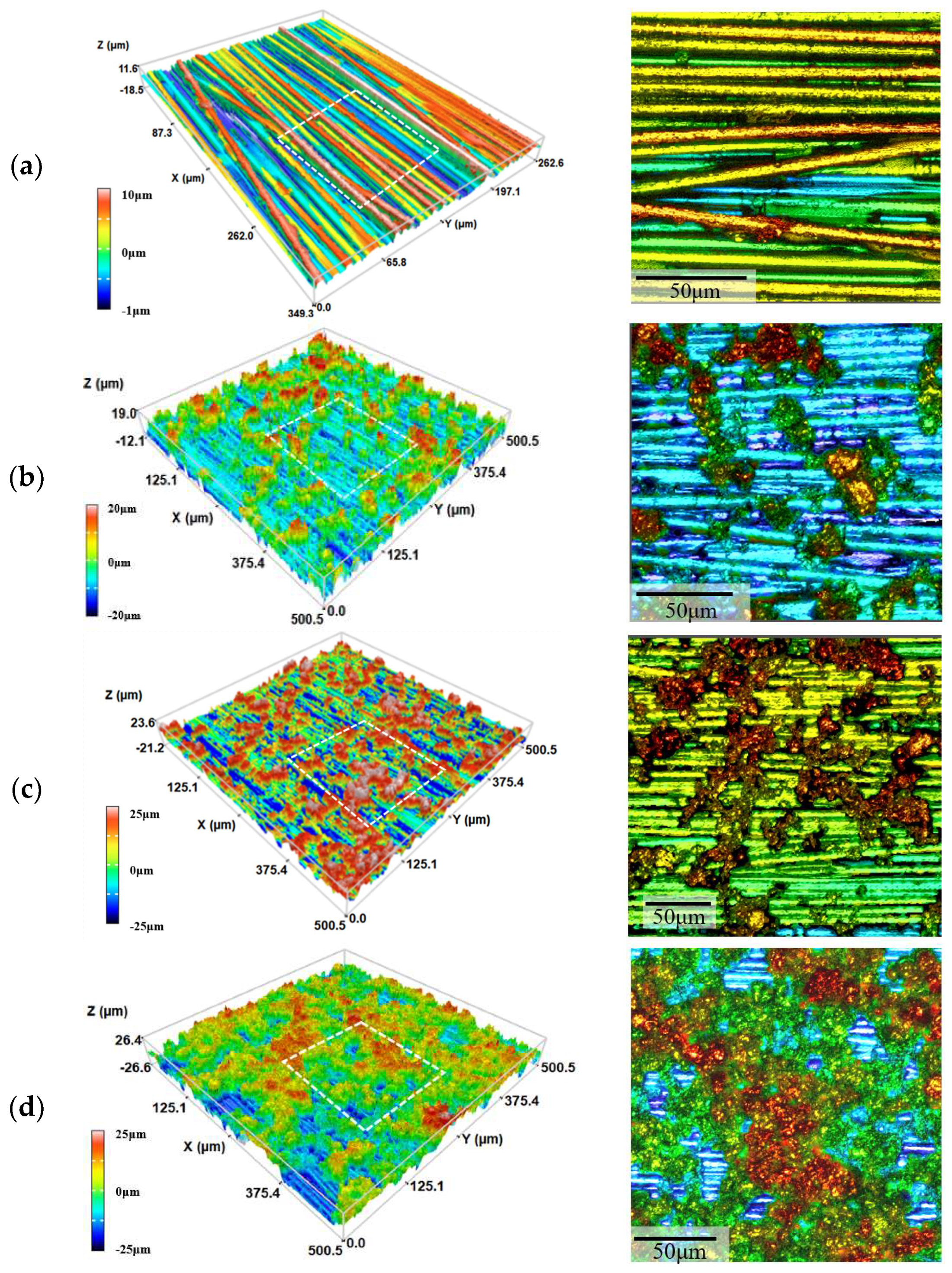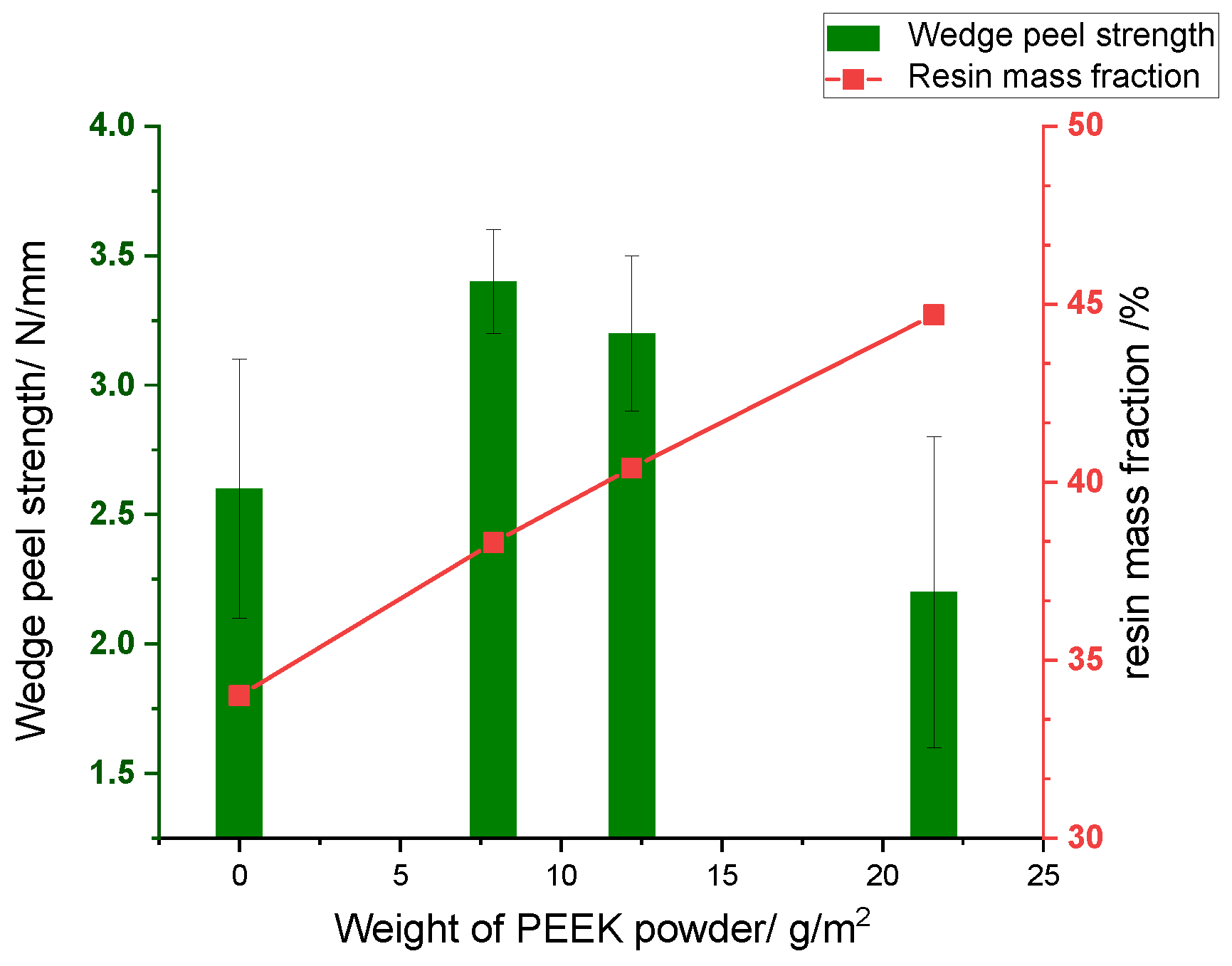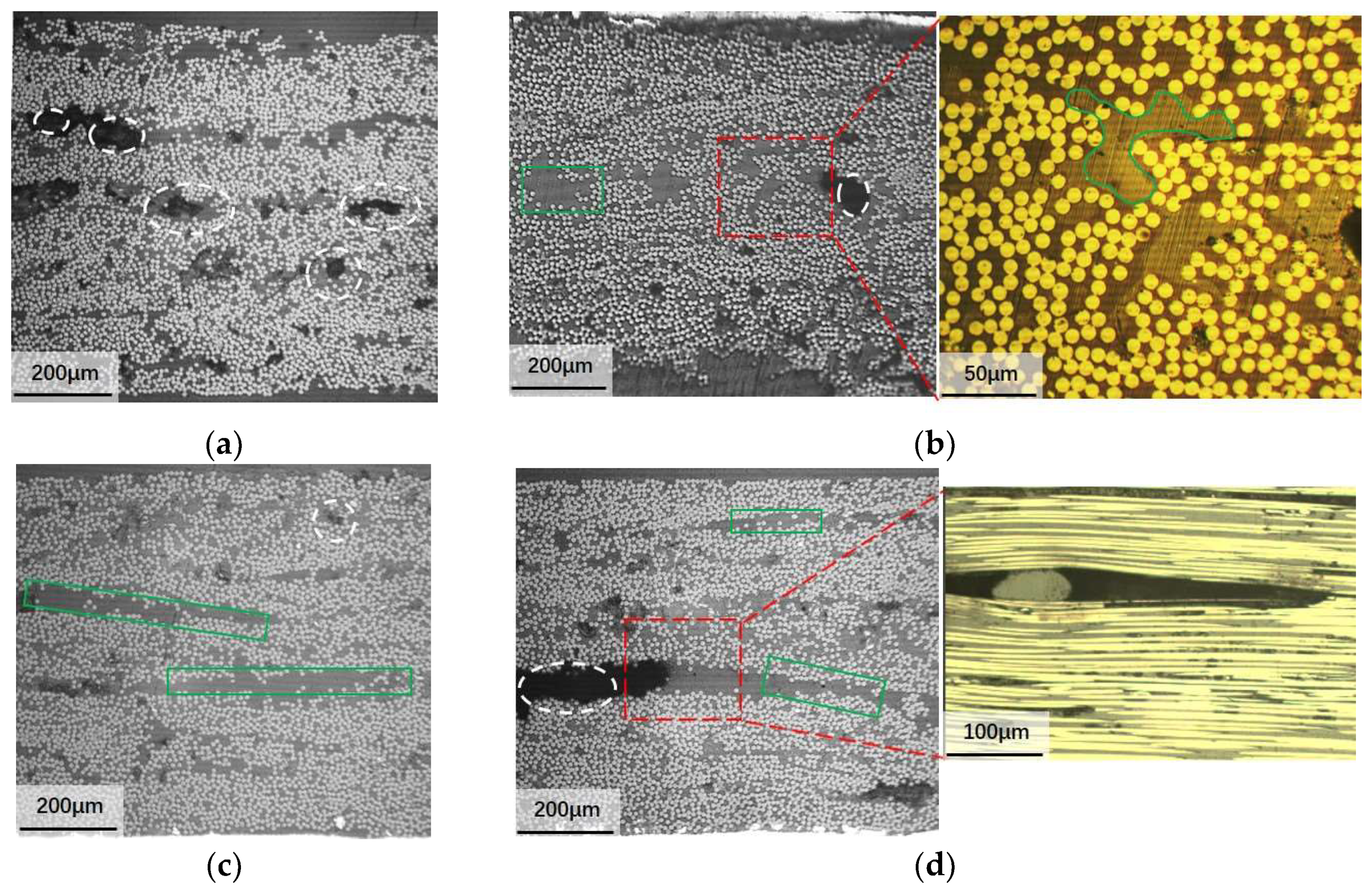The Effect of Resin Interleafing on the Wedge Peel Strength of CF/PEEK Manufactured by Laser-Assisted In Situ Consolidation
Abstract
:1. Introduction
2. Materials and Methods
2.1. Material and Equipment
2.2. Resin Powder Interleafing
2.3. Placement Trials
2.4. Interlaminar Strength Characterization
3. Results and Discussion
3.1. Surface Micrographs
3.2. Thermal History
3.3. Wedge Peel Strength
3.4. Porosity and Microstructure
4. Conclusions
Author Contributions
Funding
Institutional Review Board Statement
Informed Consent Statement
Data Availability Statement
Conflicts of Interest
References
- Mills, A. Automation of carbon fibre preform manufacture for affordable aerospace applications. Compos. Part A Appl. Sci. Manuf. 2001, 32, 955–962. [Google Scholar] [CrossRef]
- Bandaru, A.K.; Clancy, G.; Peeters, D.; O’Higgins, R.M.; Weaver, P.M. Properties of a thermoplastic composite skin-stiffener interface in a stiffened structure manufactured by laser-assisted tape placement with in situ consolidation. Compos. Struct. 2019, 214, 123–131. [Google Scholar] [CrossRef]
- Penumakala, P.K.; Santo, J.; Thomas, A. A critical review on the fused deposition modeling of thermoplastic polymer composites. Compos. Part B Eng. 2020, 201, 108336. [Google Scholar] [CrossRef]
- Qureshi, Z.; Swait, T.; Scaife, R.; El-Dessouky, H.M. In situ consolidation of thermoplastic prepreg tape using automated tape placement technology: Potential and possibilities. Compos. Part B Eng. 2014, 66, 255–267. [Google Scholar] [CrossRef]
- Comer, A.J.; Ray, D.; Obande, W.O.; Jones, D.; Lyons, J.; Rosca, I.; O’ Higgins, R.M.; McCarthy, M.A. Mechanical characterisation of carbon fibre–PEEK manufactured by laser-assisted automated-tape-placement and autoclave. Compos. Part A Appl. Sci. Manuf. 2015, 69, 10–20. [Google Scholar] [CrossRef]
- Stokes-Griffin, C.M.; Compston, P. The effect of processing temperature and placement rate on the short beam strength of carbon fibre–PEEK manufactured using a laser tape placement process. Compos. Part A Appl. Sci. Manuf. 2015, 78, 274–283. [Google Scholar] [CrossRef]
- Chen, J.; Fu, K.; Li, Y. Understanding processing parameter effects for carbon fibre reinforced thermoplastic composites manufactured by laser-assisted automated fibre placement (AFP). Compos. Part A Appl. Sci. Manuf. 2021, 140, 106160. [Google Scholar] [CrossRef]
- Liu, H.; Li, Y.; Huan, D.; Wang, W.; Li, Y.; Li, L. Influence of Curvature Feature on Laser Heating during Tape Placement Process for Carbon Fiber Reinforced Polyether Ether Ketone Composite. Polymers 2023, 15, 289. [Google Scholar] [CrossRef]
- Song, Q.; Liu, W.; Chen, J.; Zhao, D.; Yi, C.; Liu, R.; Geng, Y.; Yang, Y.; Zheng, Y.; Yuan, Y. Research on void dynamics during in situ consolidation of CF/high-performance thermoplastic composite. Polymers 2022, 14, 1401. [Google Scholar] [CrossRef]
- Miao, Q.; Dai, Z.; Ma, G.; Niu, F.; Wu, D. Effect of consolidation force on interlaminar shear strength of CF/PEEK laminates manufactured by laser-assisted forming. Compos. Struct. 2021, 266, 113779. [Google Scholar] [CrossRef]
- Lee, W.I.; Springer, G.S. A model of the manufacturing process of thermoplastic matrix composites. J. Compos. Mater. 1987, 21, 1017–1055. [Google Scholar] [CrossRef]
- Kim, Y.H.; Wool, R.P. A theory of healing at a polymer-polymer interface. Macromolecules 1983, 16, 1115–1120. [Google Scholar] [CrossRef]
- Çelik, O.; Peeters, D.; Dransfeld, C.; Teuwen, J. Intimate contact development during laser assisted fiber placement: Microstructure and effect of process parameters. Compos. Part A Appl. Sci. Manuf. 2020, 134, 105888. [Google Scholar] [CrossRef]
- Çelik, O.; Choudhary, A.; Peeters, D.; Teuwen, J.; Dransfeld, C. Deconsolidation of thermoplastic prepreg tapes during rapid laser heating. Compos. Part A Appl. Sci. Manuf. 2021, 149, 106575. [Google Scholar] [CrossRef]
- Slange, T.K.; Warnet, L.L.; Grouve, W.J.B.; Akkerman, R. Deconsolidation of C/PEEK blanks: On the role of prepreg, blank manufacturing method and conditioning. Compos. Part A Appl. Sci. Manuf. 2018, 113, 189–199. [Google Scholar] [CrossRef]
- Hulcher, A.B.; Banks, W.I., III; Pipes, R.B.; Tiwari, S.N.; Cano, R.J.; Johnston, N.J. Automated fiber placement of PEEK/IM7 composites with film interleaf layers. In Proceedings of the 46th International SAMPE Symposium and Exhibition, Covina, CA, USA, 6–10 May 2001; pp. 1998–2012. [Google Scholar]
- Miao, Q.; Dai, Z.; Ma, G.; Niu, F.; Wu, D. CF/PEEK interleaved laminates with PEEK film interleaving manufactured by laser-assisted forming: Microstructure and interlaminar shear strength. Compos. Part A Appl. Sci. Manuf. 2023, 172, 107592. [Google Scholar] [CrossRef]
- Wang, X.; Chen, C.; Hu, S.; Chen, Z.; Jiang, W.; Shen, G.; Huang, Z.; Zhou, H. In-situ infrared annealing for laser-assisted automated fiber placement to enhance interlaminar properties without sacrificing laydown efficiency. Compos. Part A Appl. Sci. Manuf. 2024, 183, 108214. [Google Scholar] [CrossRef]
- Chanteli, A.; Bandaru, A.K.; Peeters, D.; O’Higgins, R.M.; Weaver, P.M. Influence of repass treatment on carbon fibre-reinforced PEEK composites manufactured using laser-assisted automatic tape placement. Compos. Struct. 2020, 248, 112539. [Google Scholar] [CrossRef]
- Kim, J.W.; Lee, J.S. Influence of interleaved films on the mechanical properties of carbon fiber fabric/polypropylene thermoplastic composites. Materials 2016, 9, 344. [Google Scholar] [CrossRef]
- de Souza, G.; Tarpani, J.R. Interleaving CFRP and GFRP with a thermoplastic ionomer: The effect on bending properties. Appl. Compos. Mater. 2021, 28, 559–572. [Google Scholar] [CrossRef]
- Ourahmoune, R.; Salvia, M.; Mathia, T.G.; Mesrati, N. Surface morphology and wettability of sandblasted PEEK and its composites. Scanning J. Scanning Microsc. 2014, 36, 64–75. [Google Scholar] [CrossRef] [PubMed]
- Abbasnezhad, N.; Khavandi, A.; Fitoussi, J.; Arabi, H.; Shirinbayan, M.; Tcharkhtchi, A. Influence of loading conditions on the overall mechanical behavior of polyether-ether-ketone (PEEK). Int. J. Fatigue 2018, 109, 83–92. [Google Scholar] [CrossRef]
- Zhang, C.; Duan, Y.; Xiao, H.; Wang, B.; Ming, Y.; Zhu, Y.; Zhang, F. The effects of processing parameters on the wedge peel strength of CF/PEEK laminates manufactured using a laser tape placement process. Int. J. Adv. Manuf. Technol. 2022, 120, 7251–7262. [Google Scholar] [CrossRef]
- ASTM D2344; Standard Test Method for Short-Beam Strength of Polymer Matrix Composite Materials and Their Laminates. ASTM: West Conshohocken, PA, USA, 2016.
- ASTM D5528; Standard Test Method for Mode I Interlaminar Fracture Toughness of Unidirectional Fiber-Reinforced Polymer Matrix Composites. ASTM: West Conshohocken, PA, USA, 2013.
- Stokes-Griffin, C.M.; Kollmannsberger, A.; Compston, P.; Drechsler, K. The effect of processing temperature on wedge peel strength of CF/PA 6 laminates manufactured in a laser tape placement process. Compos. Part A Appl. Sci. Manuf. 2019, 121, 84–91. [Google Scholar] [CrossRef]
- Johnston, N.J.; Belvin, H.L.; Cano, R.J.; Marchello, J.M.; Hulcher, A.B. A prototype research laboratory for automated fabrication of high performance composites. In Proceedings of the 12th International Conference on Composite Materials ICCM12, Paris, France, 5–9 July 1999. [Google Scholar]
- Stokes-Griffin, C.M.; Compston, P. Investigation of sub-melt temperature bonding of carbon-fibre/PEEK in an automated laser tape placement process. Compos. Part A Appl. Sci. Manuf. 2016, 84, 17–25. [Google Scholar] [CrossRef]












| Area Density/g/m2 | Resin Mass Content/% | Thickness/mm | Glass Transformation Temperature/°C | Melting Temperature/°C | Void Content/% |
|---|---|---|---|---|---|
| 223 | 34 | 0.143 | 143 | 343 | 0.7 |
| Part Name | Part Parameter |
|---|---|
| Roller diameter | 34 mm |
| Compaction force | 10–150 N |
| Layup speed | 10–200 mm/s |
| Laser wavelength | 1064 nm |
| Laser irradiation area | 7 × 20 mm |
| Lens focal length | 400 mm |
| Material Data | Conditions | Typical Value |
|---|---|---|
| Melting temperature/°C | 343 | |
| Glass transition (Tg)/°C | 143 | |
| Thermal conductivity/Wm−1K−1 | At 23 °C | 0.29 |
| Density g/cm3 | Crystalline | 1.30 |
| Density g/cm3 | Amorphous | 1.27 |
| Melt viscosity/pa·s | at 400 °C | 90 |
| Tensile strength/MPa | 110 | |
| Tensile Modulus/GPa | 3.9 |
| Samples | Powder Layer Thickness in Average (μm) | Powder Weight (g/m2) | Resin Mass Fraction (%) | Surface Area Covered by Resin (%) |
|---|---|---|---|---|
| NP | 0 | 0 | 34 | 12.7 |
| P1 | 6.1 | 7.9 | 38.5 | 25.5 |
| P2 | 9.3 | 12.2 | 40.4 | 50.6 |
| P3 | 16.6 | 21.6 | 44.7 | 81.2 |
Disclaimer/Publisher’s Note: The statements, opinions and data contained in all publications are solely those of the individual author(s) and contributor(s) and not of MDPI and/or the editor(s). MDPI and/or the editor(s) disclaim responsibility for any injury to people or property resulting from any ideas, methods, instructions or products referred to in the content. |
© 2024 by the authors. Licensee MDPI, Basel, Switzerland. This article is an open access article distributed under the terms and conditions of the Creative Commons Attribution (CC BY) license (https://creativecommons.org/licenses/by/4.0/).
Share and Cite
Wang, R.; Xu, E.; Wen, L. The Effect of Resin Interleafing on the Wedge Peel Strength of CF/PEEK Manufactured by Laser-Assisted In Situ Consolidation. Coatings 2024, 14, 635. https://doi.org/10.3390/coatings14050635
Wang R, Xu E, Wen L. The Effect of Resin Interleafing on the Wedge Peel Strength of CF/PEEK Manufactured by Laser-Assisted In Situ Consolidation. Coatings. 2024; 14(5):635. https://doi.org/10.3390/coatings14050635
Chicago/Turabian StyleWang, Ruozhou, Entao Xu, and Liwei Wen. 2024. "The Effect of Resin Interleafing on the Wedge Peel Strength of CF/PEEK Manufactured by Laser-Assisted In Situ Consolidation" Coatings 14, no. 5: 635. https://doi.org/10.3390/coatings14050635






